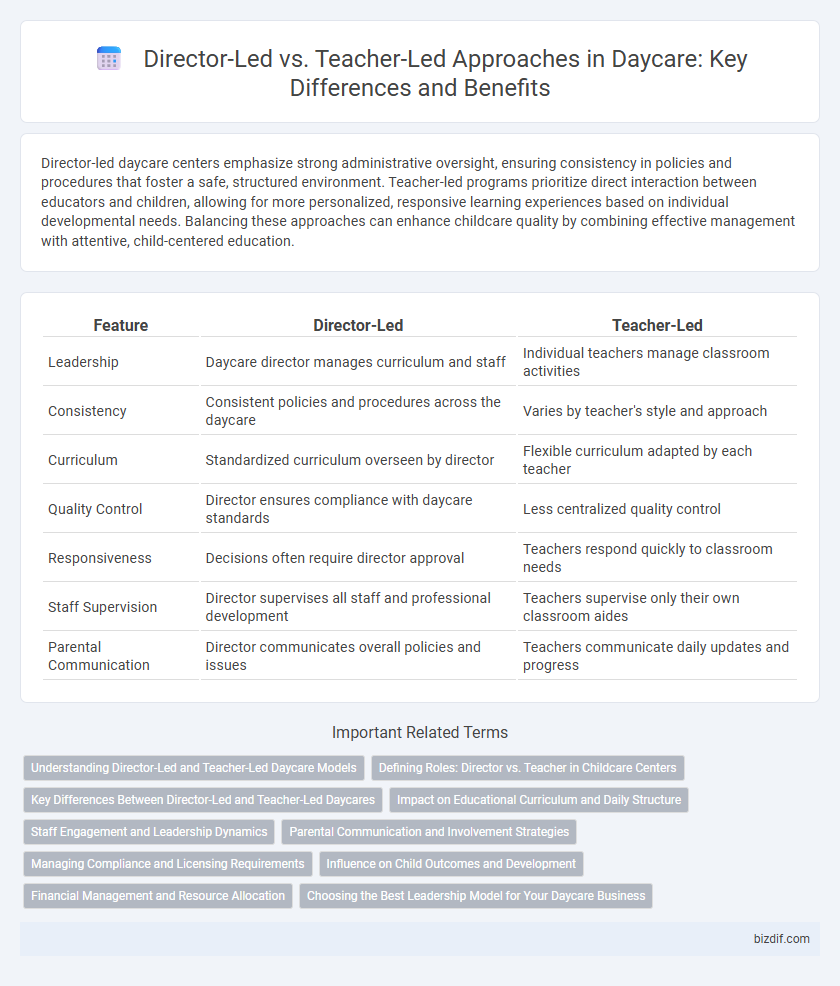Director-led daycare centers emphasize strong administrative oversight, ensuring consistency in policies and procedures that foster a safe, structured environment. Teacher-led programs prioritize direct interaction between educators and children, allowing for more personalized, responsive learning experiences based on individual developmental needs. Balancing these approaches can enhance childcare quality by combining effective management with attentive, child-centered education.
Table of Comparison
| Feature | Director-Led | Teacher-Led |
|---|---|---|
| Leadership | Daycare director manages curriculum and staff | Individual teachers manage classroom activities |
| Consistency | Consistent policies and procedures across the daycare | Varies by teacher's style and approach |
| Curriculum | Standardized curriculum overseen by director | Flexible curriculum adapted by each teacher |
| Quality Control | Director ensures compliance with daycare standards | Less centralized quality control |
| Responsiveness | Decisions often require director approval | Teachers respond quickly to classroom needs |
| Staff Supervision | Director supervises all staff and professional development | Teachers supervise only their own classroom aides |
| Parental Communication | Director communicates overall policies and issues | Teachers communicate daily updates and progress |
Understanding Director-Led and Teacher-Led Daycare Models
Director-led daycare models emphasize administrative leadership with directors overseeing curriculum development, staff management, and compliance with regulations, ensuring consistent educational standards. Teacher-led daycare focuses on classroom teachers guiding daily activities and directly engaging with children, fostering personalized learning environments and responsive care. Understanding the distinctions helps parents and stakeholders choose settings that align with their priorities for leadership, curriculum, and child development approaches.
Defining Roles: Director vs. Teacher in Childcare Centers
In childcare centers, the director is responsible for overall facility management, policy implementation, and regulatory compliance, ensuring a safe and effective learning environment. Teachers focus on direct interaction with children, delivering educational activities and fostering social-emotional development. Clear delineation of roles enhances operational efficiency and supports high-quality early childhood education.
Key Differences Between Director-Led and Teacher-Led Daycares
Director-led daycares emphasize administrative oversight, with directors managing operational policies, staff coordination, and regulatory compliance to ensure smooth facility functioning. Teacher-led daycares focus more on direct educational engagement, where teachers develop and implement daily lesson plans, nurturing individual child development and classroom dynamics. The key differences lie in leadership roles: directors prioritize overall management and compliance, whereas teachers concentrate on hands-on caregiving and learning experiences.
Impact on Educational Curriculum and Daily Structure
Director-led daycare programs emphasize strategic curriculum development and ensure cohesive daily structure aligned with educational standards, fostering a systematic learning environment. Teacher-led settings prioritize hands-on interaction and adaptive lesson delivery, allowing for flexible responses to children's developmental needs. Both approaches influence the effectiveness of early childhood education by balancing structured guidance and personalized attention in curriculum implementation.
Staff Engagement and Leadership Dynamics
Director-led daycare centers emphasize strong leadership dynamics through centralized decision-making, promoting consistent policy enforcement and clear communication channels. Teacher-led environments foster higher staff engagement by empowering educators with autonomy and collaborative responsibilities, which enhances classroom responsiveness and innovation. Balancing director oversight with teacher-driven initiatives optimizes both strategic direction and day-to-day educational quality.
Parental Communication and Involvement Strategies
Director-led daycare programs emphasize structured parental communication through scheduled meetings and formal progress reports, fostering clear expectations and consistent updates. Teacher-led approaches prioritize daily informal interactions and personalized feedback, encouraging active parental involvement in daily activities and individualized child development. Both strategies enhance parental engagement but differ in communication frequency and formality, impacting the parent-caregiver partnership quality.
Managing Compliance and Licensing Requirements
Director-led daycare management ensures strict adherence to state regulations and licensing requirements by implementing comprehensive policies and overseeing regular staff training. Teacher-led approaches emphasize frontline compliance through daily classroom practices and direct interaction with children, promoting immediate responsiveness to safety and educational standards. Combining director oversight with teacher involvement enhances overall regulatory compliance and fosters a secure, licensed learning environment.
Influence on Child Outcomes and Development
Director-led daycare programs emphasize administrative oversight and curriculum design, which ensures consistency in educational quality and compliance with standards, positively influencing child development outcomes. Teacher-led approaches prioritize direct interaction and individualized attention, fostering stronger emotional bonds and tailored learning experiences that enhance social and cognitive growth. Research indicates that a balanced integration of both leadership styles maximizes developmental benefits by combining structured guidance with responsive teaching.
Financial Management and Resource Allocation
Director-led daycare centers typically implement strategic financial management by overseeing budgeting, payroll, and resource allocation to ensure operational efficiency and sustainability. Teacher-led daycares often prioritize classroom-level resource use, focusing spending on educational materials and immediate student needs, which may limit broader fiscal oversight. Effective financial management in daycare requires balancing macro-level budget planning by directors with micro-level resource allocation by teachers to optimize educational outcomes and cost control.
Choosing the Best Leadership Model for Your Daycare Business
Director-led daycare centers ensure consistent vision and operational control, enhancing program quality and staff accountability. Teacher-led models empower educators with decision-making authority, promoting creativity and responsiveness to children's needs. Selecting the best leadership model depends on your daycare's size, staff expertise, and long-term goals for fostering a nurturing learning environment.
Director-led vs teacher-led Infographic

 bizdif.com
bizdif.com